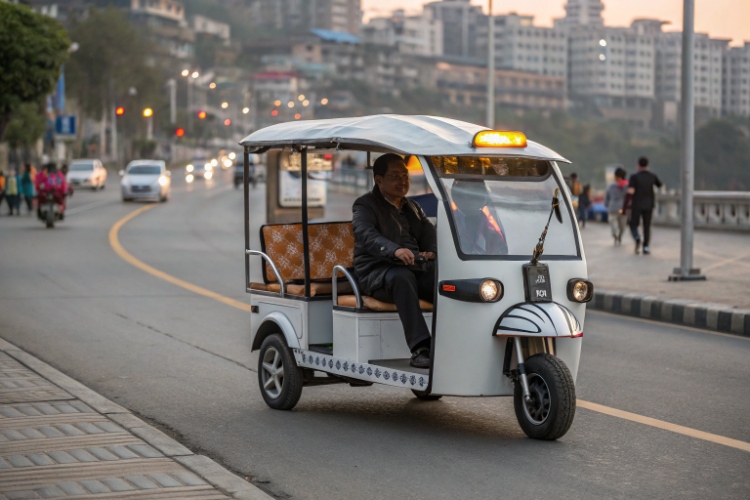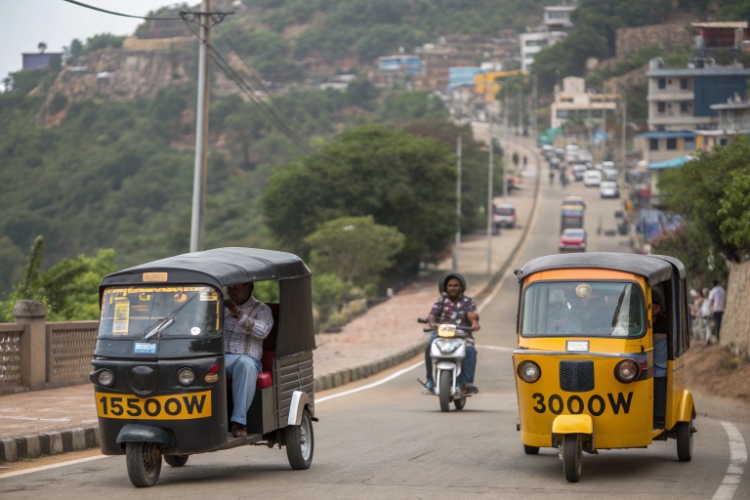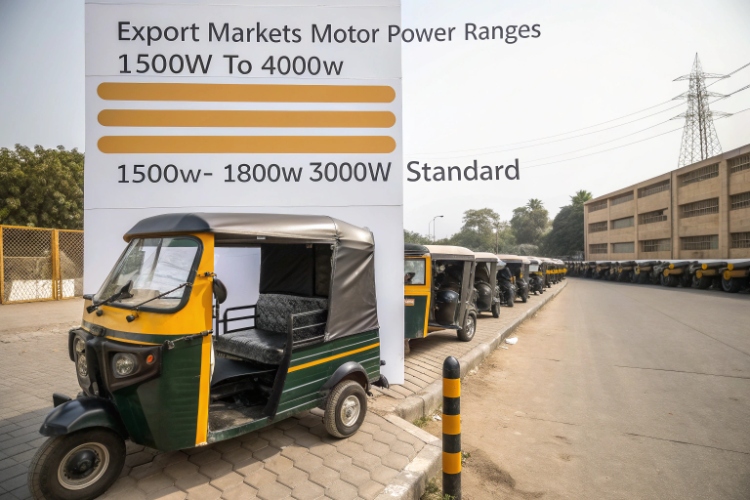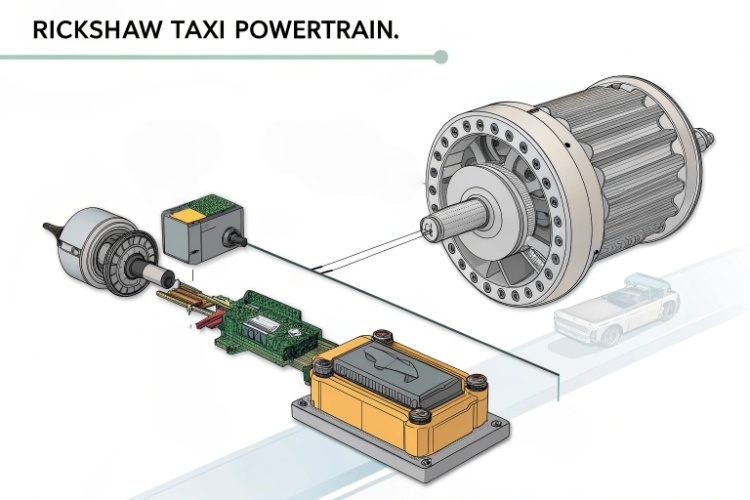You've imported a fleet of electric taxis, but your drivers are complaining. The vehicles are slow on hills and struggle with a full load of passengers, leading to longer trip times and unhappy customers.
For a standard 3-4 passenger electric rickshaw taxi, a 3000W motor is the ideal choice. It provides the best balance of climbing power for varied terrain, good acceleration for city traffic, and cost-effectiveness for daily commercial use.

Choosing the right motor is one of the most critical decisions you'll make when importing electric rickshaws. It's not just a number on a spec sheet; it directly impacts your business's daily performance and profitability. I've seen importers try to save money with underpowered motors, only to face higher maintenance costs and a damaged reputation down the line. A motor that's too weak for the job will burn out, but over-specifying can be an unnecessary expense. Let's break down how to find that perfect balance for your specific market.
How does motor wattage affect climbing ability, acceleration, and passenger load capacity?
You're comparing spec sheets, but the numbers "1500W" and "3000W" feel abstract. You don't know how they translate to a vehicle struggling up a hill versus one that accelerates smoothly into traffic.
Higher motor wattage directly translates to greater torque. This means more power to climb hills without slowing down, faster acceleration from a standstill, and the ability to carry heavier loads (like multiple passengers) with ease.

Think of wattage as the muscle of your electric rickshaw. More muscle means it can do more work without straining. We see the direct results of this in the field. A client in a flat city might be happy with a less powerful motor, but a partner in a hilly region needs more torque just to complete their daily routes. This is how the power ratings typically translate into real-world performance for a taxi.
| Kapangyarihan ng motor | Kakayahan sa Pag akyat | Acceleration & Speed | Typical Passenger Load |
|---|---|---|---|
| 1500W - 1800W | Struggles on moderate hills | Sluggish, especially when loaded | 1-2 passengers, limited cargo |
| 3000W (Standard) | Handles most urban hills well | Good, responsive for city traffic | 3-4 passengers comfortably |
| 4000W+ | Excellent, for steep terrain | Quick and powerful | 4-6 passengers or heavy loads |
Choosing a motor that is too weak for your needs is a false economy. The constant strain will cause it to overheat and fail prematurely, leading to expensive replacements and vehicle downtime.
What are the common motor power ranges for electric rickshaw taxis in export markets?
You're getting quotes from different factories with a confusing variety of motor options. You need to know which power rating is a reliable industry standard and which is a niche for specific applications.
For electric rickshaw taxis, the most common power range is 1500W to 4000W. 3000W is the versatile standard. Lower power (1500W-1800W) is for budget-focused, flat-terrain use, while 4000W+ is for high-capacity or high-performance models.

Based on the thousands of units we've exported, a clear pattern has emerged for different markets. We almost always recommend our 3000W motor configuration for new partners targeting the general taxi market. It's the sweet spot. It's powerful enough to handle the rough roads and varied terrain found in many African or South American cities while carrying 3-4 passengers all day.
Lower power options like 1500W or 1800W have their place, but it's a small one. We supply these for clients with very specific needs, like a resort in Southeast Asia that only needs to shuttle a couple of guests on perfectly flat, paved roads. Using this motor in a demanding environment like Nigeria or Peru would be a recipe for failure.
On the other end, we offer 4000W or even more powerful motors for clients who need to carry 6-7 passengers or have specific high-performance requirements. These are popular for larger "Tuk-Tuk" style vehicles used for tourist routes or as small-group transport.
How do controller settings and battery voltage influence real-world performance?
You invested in a 3000W motor, but the rickshaw feels less powerful than a competitor's model with the same rating. You're frustrated because you paid for performance you're not getting.
The motor is only one part of the powertrain. The controller, which acts as the motor's brain, and the battery voltage (e.g., 60V vs. 72V) are just as critical. A well-matched controller and higher voltage system deliver power more efficiently, improving performance and reducing heat.

This is an area where factory expertise really matters. You can't just pair any controller with any motor.
- The Controller: It dictates how much power the battery sends to the motor and how smoothly it does so. A high-quality controller matched to the motor provides instant, responsive acceleration. A poorly matched or low-amperage controller will "choke" the motor, limiting its output and making it feel sluggish.
- Battery Voltage: Higher voltage is more efficient. A 72V system can deliver the same power as a 60V system but with less electrical current (Amps). Lower current means less heat, which is better for the longevity of the motor, controller, and wiring.
Interestingly, a more powerful motor isn't always less efficient. A 3000W motor struggling at 100% capacity to climb a hill can use more energy than a 4000W motor handling the same hill at an easy 60% capacity. The under-stressed motor runs cooler and more efficiently.
How can distributors choose the right motor power based on terrain, routes, and local regulations?
You're ready to place your first container order but are hesitant to commit. Choosing the wrong motor for your specific country could make your entire inventory difficult to sell and operate.
Analyze your local market's specific needs. For hilly terrain and heavy loads, invest in 3000W or more. For flat, controlled routes with light loads, a 1500W-2000W motor can be a cost-effective choice. Always check local regulations for any power limitations.

As a factory, our goal is for you to succeed. We always ask our clients these questions before finalizing an order to ensure they get a vehicle that thrives in their market. Here's a simple guide to help you decide:
| Market Factor | Best Motor Choice | Why? |
|---|---|---|
| Hilly Cities (e.g., parts of Colombia, Kenya) | 3000W - 4000W | You need the torque to maintain speed on inclines with passengers. An underpowered motor will be too slow and overheat. |
| Flat Urban Areas (e.g., many cities in Philippines, Vietnam) | 3000W | The standard 3000W is perfect. It provides quick acceleration for traffic and handles occasional rough patches and bridges with ease. |
| Controlled Environments (Resorts, Campuses) | 1500W - 2000W | On flat, private roads with predictable light loads, you can save on the initial cost without sacrificing necessary performance. |
| High-Capacity Transport (6+ passengers) | 4000W+ | More weight requires more power, period. This ensures safe and efficient operation when the vehicle is fully loaded. |
Your best strategy is to be honest about your operating conditions. Tell us about your roads, your typical passenger load, and your business goals. We can then configure the perfect powertrain for you.
Pangwakas na Salita
Choosing the right motor is about matching the entire power system—motor, controller, and battery—to your market's real-world demands. For most taxi operations, a 3000W motor is the safest and most profitable bet.

